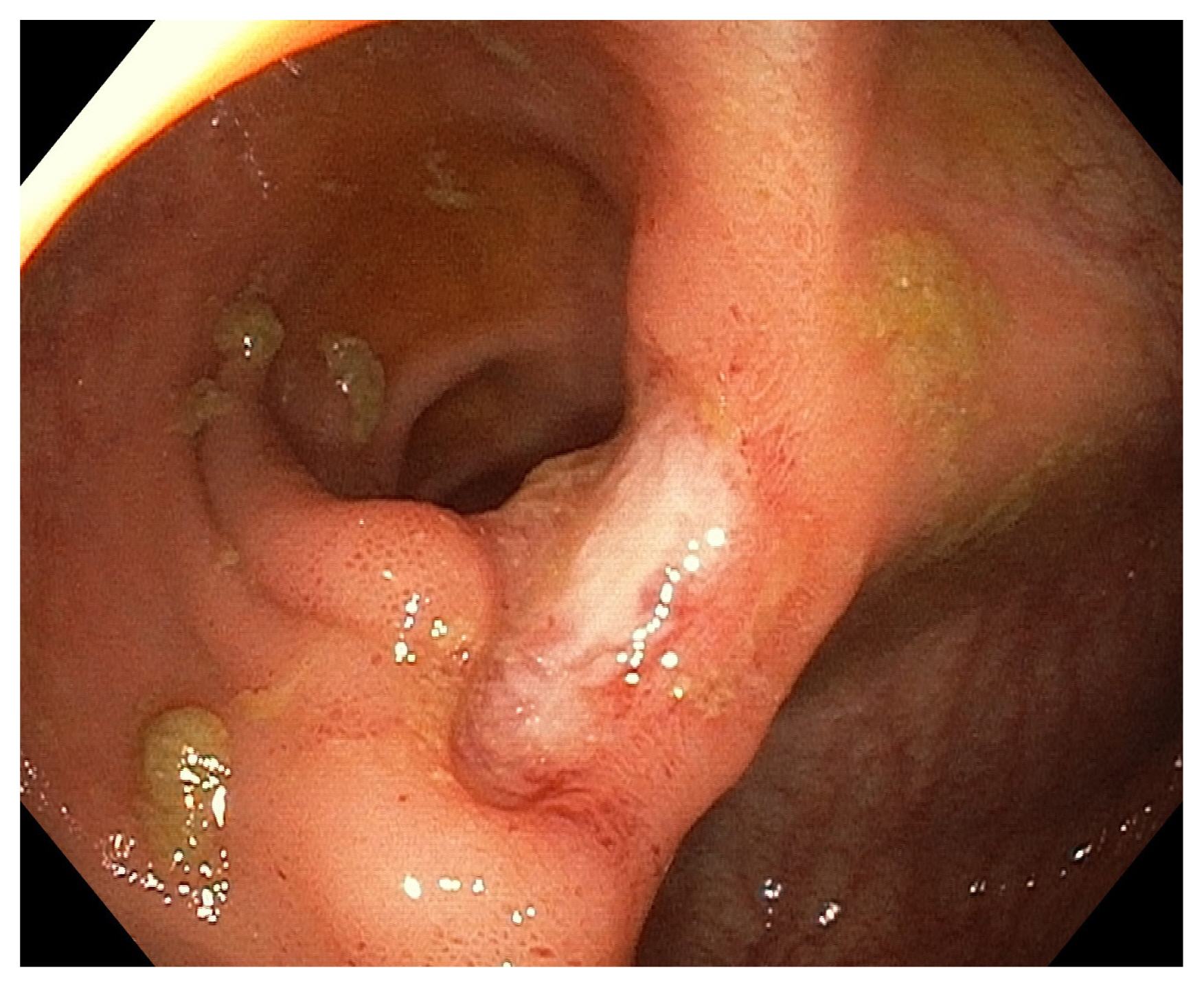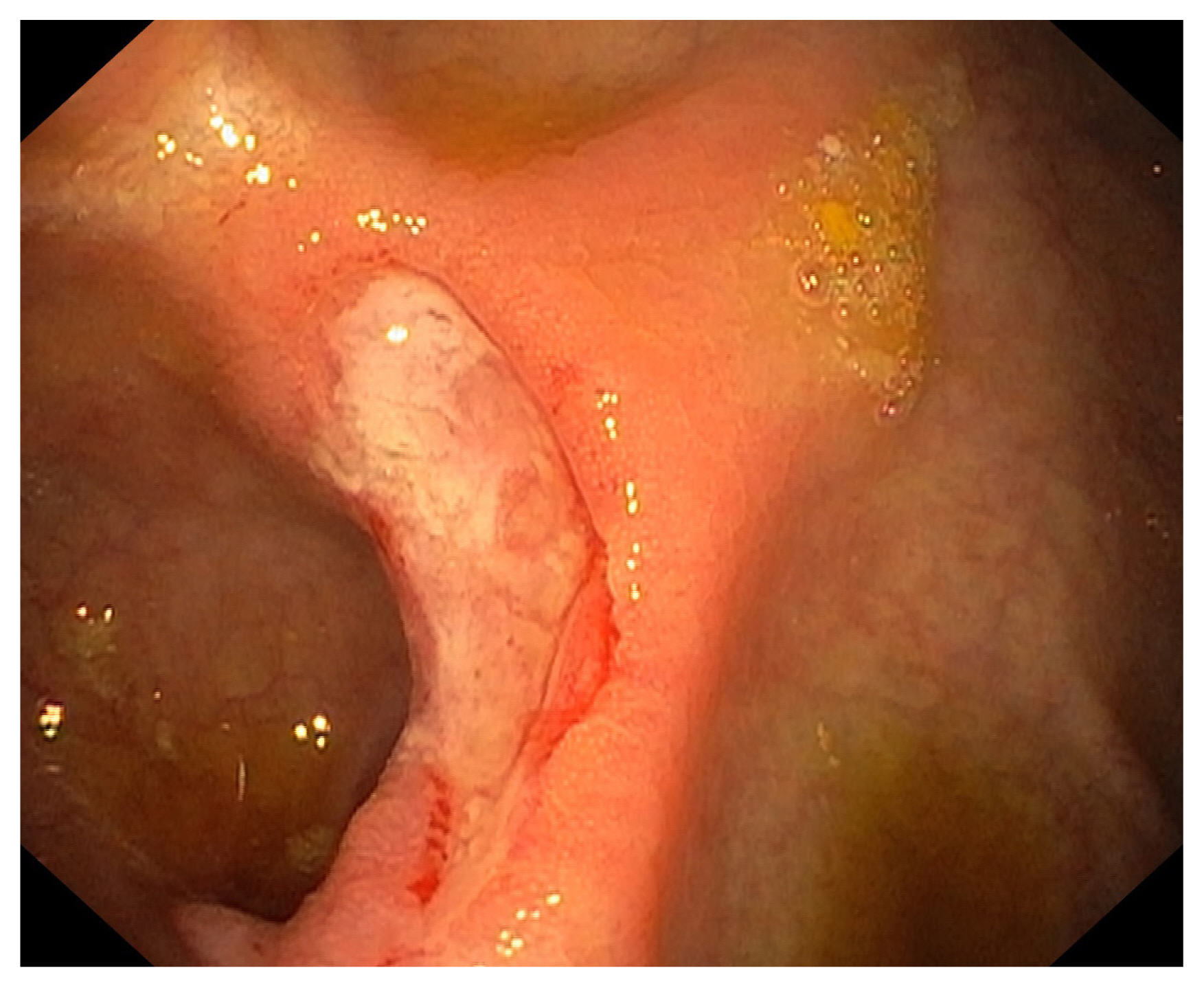Intest Res.
2021 Oct;19(4):468-471. 10.5217/ir.2020.00099.
Hydroxyurea associated ileocecal valve ulcer: evidence for causality
- Affiliations
-
- 1Gastroenterology Unit, Faculty of Medicine, Universiti Teknologi MARA, Selangor, Malaysia
- 2Department of Medicine, University of Malaya Medical Centre, Kuala Lumpur, Malaysia
- KMID: 2521610
- DOI: http://doi.org/10.5217/ir.2020.00099
Abstract
- Hydroxyurea is an antimetabolite drug that is commonly used in many hematological disorders. Ulcer formation in the gastrointestinal tract is a rare phenomenon associated with this drug. We report a case of a 73-year-old woman who was found to have an isolated ileocecal valve ulcer while on hydroxyurea 1 g daily for essential thrombocythemia. A comprehensive evaluation ruled out all other causes. The cytoreductive therapy was switched to anagrelide and the endoscopic evaluation 6 months later showed complete healing of the ulcer. However, the hydroxyurea was resumed due to increasing platelet counts and intolerance to dose increments of the anagrelide. Subsequently, the patient was found to have a recurrence of the ulcer. Apart from oral ulcers, there have also been reports of ulcers involving the small bowel and the colon associated with the use of hydroxyurea. The pathophysiology of the non-oral gastrointestinal ulceration in relation to this drug is unclear. Withdrawal of the drug typically leads to complete resolution. Increasing awareness of the rare association between the use of hydroxyurea and nonoral gastrointestinal ulcers is essential for early detection to prevent related complications.
Figure
Reference
-
1. Saban N, Bujak M. Hydroxyurea and hydroxamic acid derivatives as antitumor drugs. Cancer Chemother Pharmacol. 2009; 64:213–221.
Article2. Madaan K, Kaushik D, Verma T. Hydroxyurea: a key player in cancer chemotherapy. Expert Rev Anticancer Ther. 2012; 12:19–29.3. Vassallo C, Passamonti F, Merante S, et al. Muco-cutaneous changes during long-term therapy with hydroxyurea in chronic myeloid leukaemia. Clin Exp Dermatol. 2001; 26:141–148.4. Randi ML, Ruzzon E, Luzzatto G, Tezza F, Girolami A, Fabris F. Safety profile of hydroxyurea in the treatment of patients with Philadelphia-negative chronic myeloproliferative disorders. Haematologica. 2005; 90:261–262.5. Martínez-Trillos A, Gaya A, Maffioli M, et al. Efficacy and tolerability of hydroxyurea in the treatment of the hyperproliferative manifestations of myelofibrosis: results in 40 patients. Ann Hematol. 2010; 89:1233–1237.
Article6. Hernández-Boluda JC, Alvarez-Larrán A, Gómez M, et al. Clinical evaluation of the European LeukaemiaNet criteria for clinicohaematological response and resistance/intolerance to hydroxycarbamide in essential thrombocythaemia. Br J Haematol. 2011; 152:81–88.
Article7. Alvarez-Larrán A, Pereira A, Cervantes F, et al. Assessment and prognostic value of the European LeukemiaNet criteria for clinicohematologic response, resistance, and intolerance to hydroxyurea in polycythemia vera. Blood. 2012; 119:1363–1369.8. Antonioli E, Guglielmelli P, Pieri L, et al. Hydroxyurea-related toxicity in 3,411 patients with Ph’-negative MPN. Am J Hematol. 2012; 87:552–554.
Article9. Demuynck T, Verhoef G, Delforge M, Vandenberghe P, Devos T. Polycythemia vera and hydroxyurea resistance/intolerance: a monocentric retrospective analysis. Ann Hematol. 2019; 98:1421–1426.
Article10. Norhaya MR, Cheong SK, Ainoon O, Hamidah NH. Painful oral ulcers with hydroxyurea therapy. Singapore Med J. 1997; 38:283–284.11. Paleri V, Lindsey L. Oral ulcers caused by hydroxyurea. J Laryngol Otol. 2000; 114:976–977.
Article12. Mendonça R, Gueiros LA, Capellaro K, Pinheiro VR, Lopes MA. Oral lesions associated with hydroxyurea treatment. Indian J Dent Res. 2011; 22:869–870.
Article13. Badawi M, Almazrooa S, Azher F, Alsayes F. Hydroxyurea-induced oral ulceration. Oral Surg Oral Med Oral Pathol Oral Radiol. 2015; 120:e232–e234.
Article14. Yousuf K, Kathula S, Hillman N, et al. A case of bleeding jejunal ulcer due to vasculitis from hydroxyurea. Am J Gastroenterol. 2000; 95:2616.15. Kobune M, Kato J, Kuribayashi K, et al. Essential thrombocythemia associated with incomplete type intestinal Behçet disease during hydroxyurea treatment. Rinsho Ketsueki. 2005; 46:1136–1140.16. Boonyawat K, Wongwaisayawan S, Nitiyanant P, Atichartakarn V. Hydroxyurea and colonic ulcers: a case report. BMC Gastroenterol. 2014; 14:134.
Article
- Full Text Links
- Actions
-
Cited
- CITED
-
- Close
- Share
- Similar articles
-
- Hydroxyurea-induced Multiple Skin Ulcers
- Cytomegalovirus Colitis Manifested with a Ring like Ileocecal Valve Ulcer in a Korean AIDS Patient
- A Hydroxyurea-induced Leg Ulcer
- A Case of Dieulafoy-like Lesion with Massive Bleeding at Ileocecal Valve Following Acute Infectious Colitis in a Pediatric Patient
- Behget's Disease vs Crohn's Disease : Differentiation with Double Contrast Barium Enema




